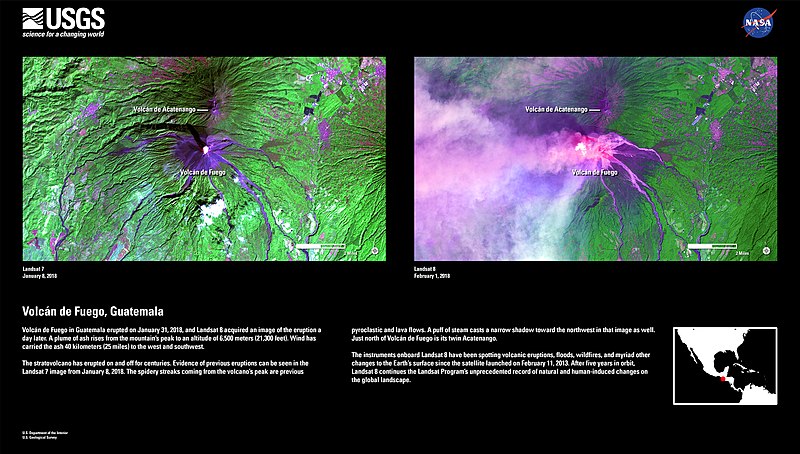File:Volcan-de-Fuego-v2.jpg

Original file (5,288 × 3,000 pixels, file size: 3.39 MB, MIME type: image/jpeg)
Captions
Captions
Summary[edit]
| DescriptionVolcan-de-Fuego-v2.jpg |
English: Volcán de Fuego in Guatemala erupted on January 31, 2018, and Landsat 8 acquired an image of the eruption a day later. A plume of ash rises from the mountain’s peak to an altitude of 6,500 meters (21,300 feet). Wind has carried the ash 40 kilometers (25 miles) to the west and southwest.
The stratovolcano has erupted on and off for centuries. Evidence of previous eruptions can be seen in the Landsat 7 image from January 8, 2018. The spidery streaks coming from the volcano’s peak are previous pyroclastic and lava flows. A puff of steam casts a narrow shadow toward the northwest in that image as well. Just north of Volcán de Fuego is its twin Acatenango. The instruments onboard Landsat 8 have been spotting volcanic eruptions, floods, wildfires, and myriad other changes to the Earth’s surface since the satellite launched on February 11, 2013. After five years in orbit, Landsat 8 continues the Landsat Program’s unprecedented record of natural and human-induced changes on the global landscape. |
| Date | |
| Source |
Volcán de Fuego in Guatemala erupted on January 31, 2018, and Landsat 8 acquired an image of the eruption a day later. A plume of ash rises from the mountain’s peak to an altitude of 6,500 meters (21,300 feet). Wind has carried the ash 40 kilometers (25 miles) to the west and southwest. The stratovolcano has erupted on and off for centuries. Evidence of previous eruptions can be seen in the Landsat 7 image from January 8, 2018. The spidery streaks coming from the volcano’s peak are previous pyroclastic and lava flows. A puff of steam casts a narrow shadow toward the northwest in that image as well. Just north of Volcán de Fuego is its twin Acatenango. The instruments onboard Landsat 8 have been spotting volcanic eruptions, floods, wildfires, and myriad other changes to the Earth’s surface since the satellite launched on February 11, 2013. After five years in orbit, Landsat 8 continues the Landsat Program’s unprecedented record of natural and human-induced changes on the global landscape. |
| Author | U.S. Department of the Interior | U.S. Geological Survey |
Licensing[edit]
| Public domainPublic domainfalsefalse |
This image is in the public domain in the United States because it only contains materials that originally came from the United States Geological Survey, an agency of the United States Department of the Interior. For more information, see the official USGS copyright policy.
Bahasa Indonesia ∙ català ∙ čeština ∙ Deutsch ∙ eesti ∙ English ∙ español ∙ français ∙ galego ∙ italiano ∙ Nederlands ∙ português ∙ polski ∙ sicilianu ∙ suomi ∙ Tiếng Việt ∙ Türkçe ∙ български ∙ македонски ∙ русский ∙ മലയാളം ∙ 한국어 ∙ 日本語 ∙ 中文 ∙ 中文(简体) ∙ 中文(繁體) ∙ العربية ∙ فارسی ∙ +/− |
File history
Click on a date/time to view the file as it appeared at that time.
| Date/Time | Thumbnail | Dimensions | User | Comment | |
|---|---|---|---|---|---|
| current | 10:50, 6 June 2018 |  | 5,288 × 3,000 (3.39 MB) | LuisArmandoRasteletti (talk | contribs) | User created page with UploadWizard |
You cannot overwrite this file.
File usage on Commons
There are no pages that use this file.
File usage on other wikis
The following other wikis use this file:
- Usage on ast.wikipedia.org
- Usage on es.wikipedia.org
- Usage on ro.wikipedia.org
Metadata
This file contains additional information such as Exif metadata which may have been added by the digital camera, scanner, or software program used to create or digitize it. If the file has been modified from its original state, some details such as the timestamp may not fully reflect those of the original file. The timestamp is only as accurate as the clock in the camera, and it may be completely wrong.
| Width | 8,721 px |
|---|---|
| Height | 7,881 px |
| Bits per component |
|
| Compression scheme | Uncompressed |
| Pixel composition | RGB |
| Orientation | Normal |
| Number of components | 3 |
| Horizontal resolution | 150 dpi |
| Vertical resolution | 150 dpi |
| Data arrangement | planar format |
| Software used | Adobe Photoshop CC 2017 (Macintosh) |
| File change date and time | 08:57, 27 March 2018 |
| Color space | Uncalibrated |
| Date and time of digitizing | 07:59, 15 October 2009 |
| Date metadata was last modified | 03:57, 27 March 2018 |
| Unique ID of original document | uuid:FB1AD7C31BBBDE118D54DFC875B69646 |
